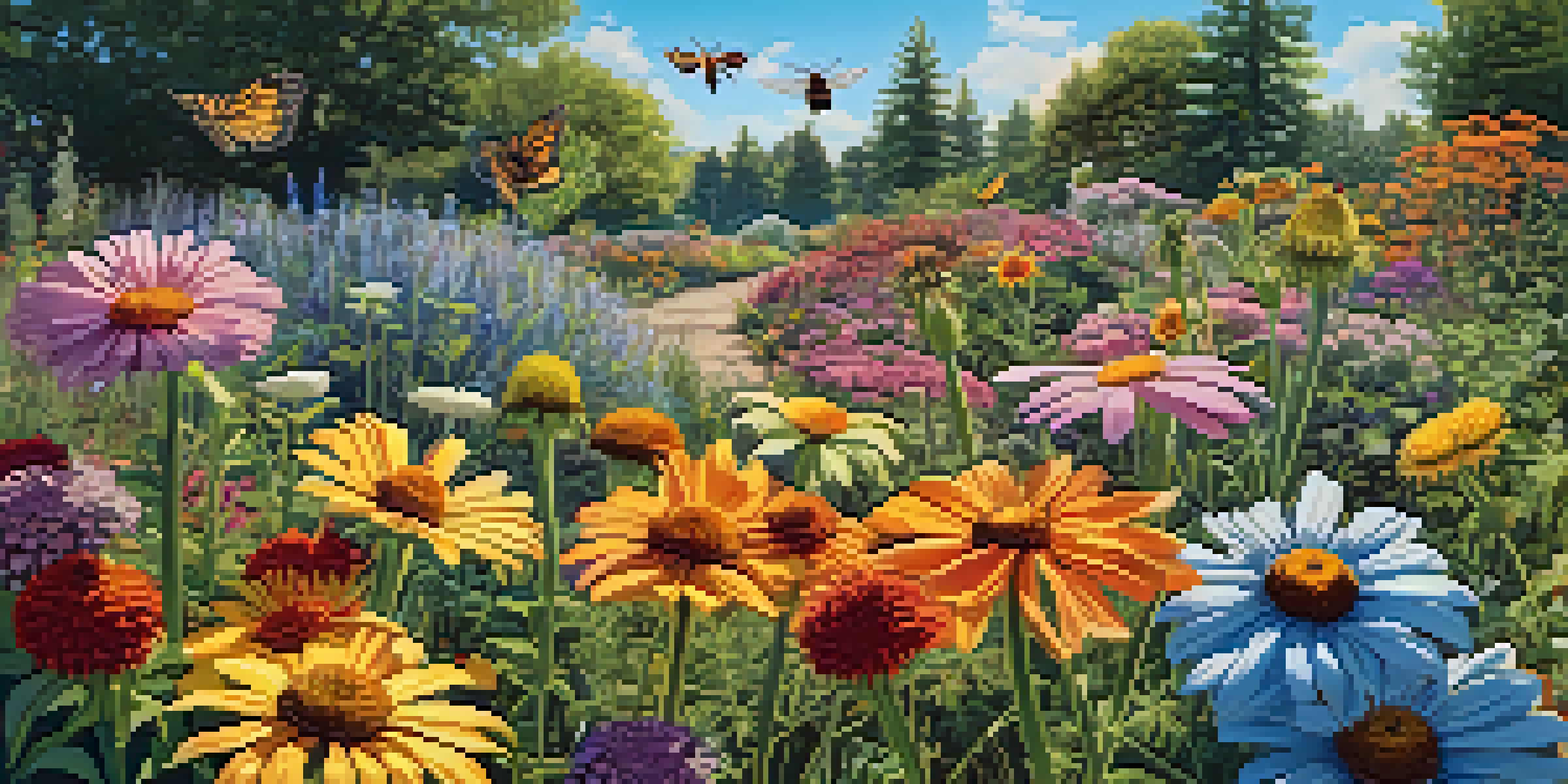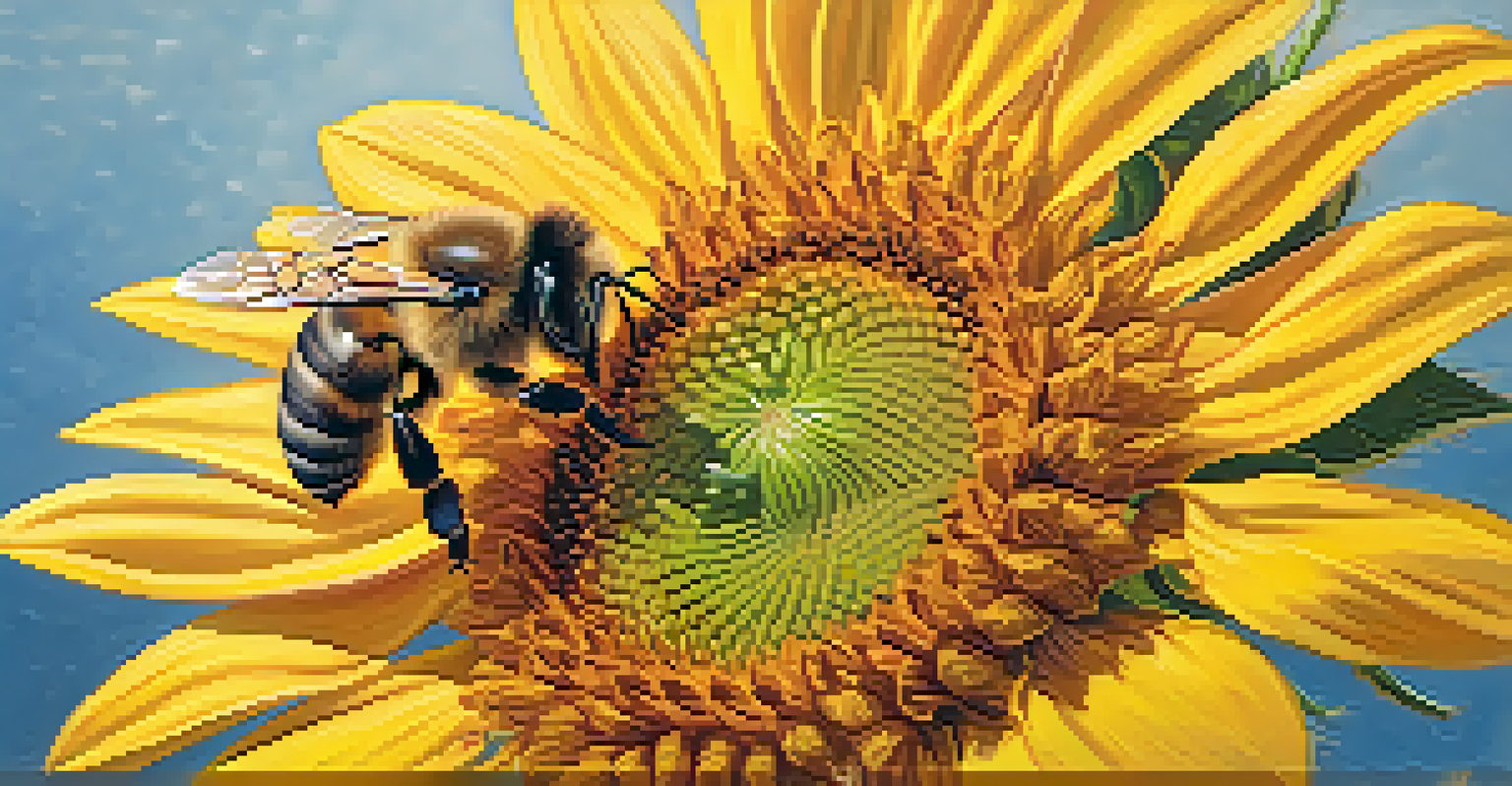The Role of Pollinators in Flowering Plant Reproduction

Understanding Pollinators and Their Importance
Pollinators, such as bees, butterflies, and birds, play a crucial role in the ecosystem. They facilitate the transfer of pollen from one flower to another, which is essential for fertilization. Without these tiny helpers, many flowering plants would struggle to reproduce, leading to a decline in biodiversity.
If bees disappeared off the face of the earth, man would only have four years left to live.
In fact, it’s estimated that one out of every three bites of food we consume relies on pollination. This includes fruits, vegetables, and nuts that are staples in our diets. The relationship between pollinators and plants is a beautiful example of nature’s interconnectedness.
By understanding the importance of pollinators, we can better appreciate the delicate balance of our ecosystems. This awareness can inspire us to take action in protecting these vital species and their habitats.
How Pollination Works: A Simple Overview
Pollination begins when a pollinator visits a flower in search of nectar, a sugary liquid that provides them with energy. As they move from flower to flower, they inadvertently pick up pollen, which is the male gamete of the plant. When they visit another flower, this pollen can be transferred to the stigma, the female part of the flower.

This process is not just a random occurrence; it’s a finely-tuned dance of nature. Different plants may rely on specific pollinators due to their unique shapes and colors, which attract certain species. For example, tubular flowers often attract hummingbirds, while bright and fragrant blooms lure in bees.
Pollinators Are Essential for Food
One out of every three bites of food we eat relies on pollination, highlighting their crucial role in our diets.
The successful transfer of pollen leads to fertilization, resulting in seeds and fruits. This cycle of life is essential for the survival of many plants, which in turn support various animals, including humans.
Types of Pollinators: Who Are They?
Pollinators come in many forms, but the most well-known are insects like bees and butterflies. Bees, in particular, are responsible for the majority of pollination globally. Their fuzzy bodies are perfect for collecting and transferring pollen, making them incredibly efficient at their job.
The future will be shaped by the actions we take today, or the inaction we choose to ignore.
Apart from insects, birds and bats also play significant roles in pollination. Hummingbirds, for example, are attracted to brightly colored flowers and are essential for pollinating many tropical plant species. Bats, often overlooked, are crucial for night-blooming plants, showcasing the diversity of pollinators.
Even some small mammals, like certain rodents, contribute to pollination. This variety of pollinators highlights the importance of protecting all species and their habitats to ensure the continued reproduction of flowering plants.
The Impact of Pollinator Decline on Ecosystems
Unfortunately, pollinators are facing significant threats due to habitat loss, pesticide use, and climate change. These factors have led to alarming declines in their populations, which can have dire consequences for flowering plants and the entire ecosystem. A drop in pollinator numbers can result in reduced fruit and seed production, affecting food availability for many species.
Moreover, the decline of pollinators can disrupt the balance of the ecosystem. Without adequate pollination, certain plants may become less abundant, which can lead to a decrease in the animal species that rely on those plants for food and shelter. This chain reaction can ultimately threaten biodiversity.
Pollinator Declines Threaten Ecosystems
The decline of pollinators due to habitat loss and climate change can disrupt ecosystems and threaten biodiversity.
Addressing these challenges is critical for maintaining healthy ecosystems. By promoting sustainable practices and protecting natural habitats, we can help ensure that pollinators thrive.
Cultivating Pollinator-Friendly Gardens
Creating a pollinator-friendly garden is a simple yet impactful way to support these essential creatures. Start by planting a variety of native flowering plants that bloom at different times throughout the season. This ensures that pollinators have a consistent food source from early spring to late fall.
Incorporating features such as water sources, shelter, and avoiding pesticides can also create a welcoming environment for pollinators. Even small changes, like leaving some areas of your garden wild, can provide habitat for ground-nesting bees and other pollinators.
By taking these steps, you can play a part in boosting local pollinator populations. Not only will your garden thrive, but you’ll also contribute to the health of the surrounding ecosystem.
The Role of Education in Pollinator Conservation
Education plays a vital role in raising awareness about the importance of pollinators. Schools, community organizations, and online platforms can help spread knowledge about the challenges pollinators face and how individuals can make a difference. Workshops, presentations, and hands-on activities can engage people of all ages in conservation efforts.
By fostering a deeper understanding of the role of pollinators, we can inspire action at both the individual and community levels. Simple initiatives, like planting pollinator gardens or participating in local clean-up events, can have a profound impact.
Creating Pollinator-Friendly Habitats
Cultivating gardens with native plants and avoiding pesticides can support pollinator populations and contribute to ecosystem health.
Moreover, educating future generations ensures that the importance of pollinators is recognized and valued. This ongoing dialogue can help cultivate a culture of stewardship and responsibility toward our natural world.
The Future of Pollinators: Hope and Action
The future of pollinators is not set in stone; it depends on the actions we take today. With increasing awareness and advocacy, there is hope for reversing some of the declines in pollinator populations. Community efforts, policy changes, and individual choices can all contribute to creating a more sustainable environment.
Organizations around the world are working tirelessly to research, protect, and restore pollinator habitats. These initiatives are critical for maintaining biodiversity and ensuring food security. Everyone can play a role, whether by supporting local conservation efforts or making informed choices in our daily lives.

As we look to the future, let’s remember that every small action counts. Together, we can create a world where pollinators thrive, ensuring a healthy planet for generations to come.